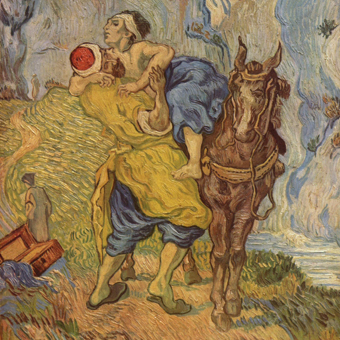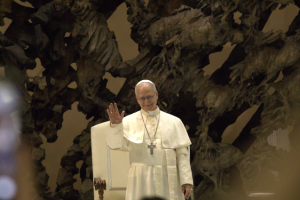The Good Samaritan points the way to a humbler, holier church.
We need more humility in the church today. It is a sad truth that these days we live in a divided church, as we do in our society in general, where deep differences prevent people of the same faith from talking to one another or even worshiping together.
Without humility, without the possibility of questioning our own views or truly listening to those of others, we inevitably fall into the vice of exclusion. Indeed, many of the ills in our church today are products of the sin of exclusion and could be addressed by closer attention to the virtue of humility. Humility and shutting someone else out really just don’t sit well together. We can see this in the self-righteousness of groups such as the Catholic League or the Cardinal Newman Society, where tiny minorities of well-organized individuals set themselves up as the guardians of orthodoxy and forget that the very word catholic implies unity, not uniformity.
St. Paul addressed the dangers of exclusion and the need for humility in his First Letter to the Corinthians. Corinth was a divided church, not unlike our own in many ways. It was beset with rivalries, puffed up with belief in its own wisdom, with church members suing one another in secular courts and, notoriously, destroying the unity of the Lord’s Supper. Paul’s remedy is unity, not uniformity. We must be one body but many parts. Love is patient, love is kind, he writes. The cure for division is rejoicing in diversity.
The most wonderful example of how differences can be healed by bowing humbly before the other person is afforded us in Jesus’ parable of the Good Samaritan. Often enough we read it as if it is just about caring for our neighbor, and it surely is about that. But the more closely we read it the more surprising we find the depths of its message to be a message that is as fresh now as it was when Jesus’ followers sparked him to teach the parable by asking the famous question, “Who, then, is my neighbor?” (Luke 10:29)
The first way we can think about the parable of the Good Samaritan is from the perspective of the church, as it praises and thanks God for the church as a gift to the world, as something truly holy. This was the perspective of Israel before it was that of the church.
Both in the Hebrew Bible and in the Christian New Testament the people of God are holy not in themselves but because God calls them together for a purpose larger than the mere existence of the community itself. Israel is called to be a light to the nations, as in Isaiah’s words, “I shall submit you as a light unto the nations, to be my salvation until the end of the earth” (49:6). And the Christian community of faith is described in the gospels as “the light of the world” (Matt. 5:14).
Light attracts, like moths to a flame, and light gives light to those who are in darkness. Both the mission of Israel and that of the Christian church include drawing people to the covenant community or the communion of saints and going out into the world to share the light.
The great French theologian Yves Congar once wrote that church and world are not to be imagined “like two crowned sovereigns looking sideways at one another as they sit on the same dais” but “much more like the Good Samaritan holding in his arms the half-dead man, whom he will not leave because he has been sent to help him.”
Identifying the church with the Good Samaritan reaching out to the wounded victim is a good way to show the importance of mission and to draw attention to the fact that the church throughout history has been a source of support and consolation to suffering people, Catholic or not. This work is an integral component of mission and witness without which the proclamation of the Good News of Jesus Christ is incomplete.
But this truth can lead us to be too narrow. When we set out to take the lessons of the Good Samaritan to heart and see the church, as Congar suggested, in some measure succeed in being that church of compassion and service, we may be too focused on being the star of the show of salvation history. To be sure, Christians believe that the world needs the saving message of faith. But that does not mean that there is no wisdom in the world, wisdom that even we could learn from.
The parable of the Good Samaritan is certainly about doing good to the other, but we need to read it carefully if we are not to fall into the sin of pride in which we are the good and the holy ones, extending our hand to those who are not. This happens when we rejoice in our identification with the model of concern for others and forget the disquieting context in which the parable is told.
We Christians may identify ourselves with the Good Samaritan who comes to the aid of the victim, but we are also the priest and Levite who are too busy about the “things of God” to be aware of the cries of the victim. In this parable Jesus is not so much teaching us to be kind as expanding our sense of to whom we need to extend our aid.
The parable of the Good Samaritan is less a story about doing good than it is about breaking boundaries. The traditional orthodoxies of Judaism are challenged by the choice of a heretic, an unbeliever, an outcast from the covenant community as a model to be imitated. Even more, the story insists that there are no boundaries to neighborliness. Love your neighbor as yourself is not about limits (“Who is my neighbor?”) but about the absence of limits (“Everyone!”).
The lawyer, the priest, and the Levite work within the law and want to know what it requires. Jesus teaches them to abandon it. The consequences of this parable for interpreting the right relationship between church and world are thus considerable, and they are not exhausted by Congar’s image of the church as Samaritan embracing the victim.
While it is appropriate that the church celebrates its God-given role, there is an equally important need to look to the world that God created and to examine how the church and the world are related.
As the Anglican Archbishop of Canterbury Rowan Williams once wrote, we have to go out into the world “to witness to the gospel’s capacity for being at home in more than one cultural environment, and to display enough confidence to believe that this gospel can be rediscovered at the end of a long and exotic detour through strange idioms and structures of thought.”
When we can enter into dialogue with the world that is not the church, we can see this as an act of confidence in the robustness of the fundamentals of our faith that can then be open to learning from other cultures, other traditions, and other faiths. The communication is two-way. As we teach we learn. We talk and we listen. And our own beliefs can be strengthened by the encounter.
Something like this happened in the encounter between the Samaritan and the wounded victim. Their meeting was not all about what the Samaritan could do for the one who had been attacked. In reaching out to the victim the Samaritan gives something up, loses something, but gains something more important. He is poorer in monetary terms and he is inconvenienced in human terms, but he is enriched in his sense of his own humanity by the act of generosity.
And the victim, while he is enormously aided by the material provisions the Samaritan makes for him, is arguably aided more by being recognized not as a victim but as another human being. The care the Samaritan extends to the victim shows the equal human dignity of both and raises the victim back to the level that his victimization had destroyed.
In the past the church has sometimes seemed to be afraid of what is different, particularly in what Jesuit historian John O’Malley calls “the long 19th century,” stretching from the French Revolution in 1789 to the eve of the Second Vatican Council. It is hard not to see something like Pope Pius IX’s 1864 Syllabus of Errors or the First Vatican Council’s 1870 definition of papal infallibility—however formally correct they may have been in their times—as driven by a determination to assert the rightness of the church over the wrongness of the world.
And if after Vatican II we have largely moved beyond the demonization of the religious other, it still remains true that when the church uses language like that in documents such as the 2000 declaration Dominus Iesus, or creates an “ordinariate” for conservative Anglicans fleeing their church—however formally correct these may be—they do nothing whatsoever to draw the church and the world closer together. In fact, we need to recognize that if no lasting damage is done, it is due to the forbearance of those who are not part of the church, and not the generosity of those who are.
Too often we fail to see that our love of the world is our love of God and that our love of God is our love of the world. And yet there must be a difference, if Congar is right that the church and the world are related to one another “not like two crowned sovereigns looking sideways at one another as they sit on the same dais” but “much more like the Good Samaritan holding in his arms the half-dead man, whom he will not leave because he has been sent to help him.”
On the other hand, and lest we think Congar is suggesting a smothering kind of embrace, there is also his warning that “final salvation will be achieved by a wonderful refloating of our earthly vessel, rather than by a transfer of the survivors to another ship wholly built by God.”
The church and the world, then, are engaged in a collaborative venture in which the world, “our earthly vessel” will be “wonderfully refloated.” They are not at loggerheads with one another, they are not enemies. They are not casting sidelong glances at one another, but locked in the embrace of Samaritan and victim, in which both gain.
Let’s take one last look at the Good Samaritan parable. We have explored the value and the limitations of Congar’s image of the Good Samaritan embracing the wounded victim as an image of the church-world relationship. But we have not so far noted that there is no particular reason to identify the church with the Good Samaritan and the world with the wounded victim. Isn’t it just as possible to turn things around?
The point of the parable after all was not to teach the people to be good, but to show them their narrowness of vision. While we in the church have perhaps had some success getting Jesus’ point that “neighbor” knows no limits, we have not been as successful in recognizing that we may be the wounded person in need of the lesson of humanity provided by the outcast.
When we move as a church in grace, we are the Samaritan, but when we are full of sin, we are the wounded victim silently beseeching the world beyond the church for saving help.
In our embrace of the world we are not healing the sinner so much as encountering the grace of God in unexpected places. We do not come to a richer humanity unilaterally, but rather in dialogue with other sources of divine grace. When the council fathers said that there is a real sense in which the church must learn from the world, they meant that we need its help in order to be more fully the church of God.
As the Catholic philosopher Charles Taylor has written, there are things the church has learned from the world that it would not have discovered from its own resources. There is no reason to think that the process has come to an end, though there seems to be little evidence in our church today that we recognize even the possibility of worldly wisdom leading us to modify our traditional positions.
There is another outsider in the gospels: the Canaanite woman in Matthew 15, whose extraordinary exchange with Jesus supports this understanding of the Good Samaritan parable in surprising fashion. The story is of the woman begging Jesus to heal her daughter and the rebuff to her, “I was sent only to the lost sheep of the house of Israel.” She entreats him further, and in a perplexingly brutal response Jesus says, “It is not fair to take the children’s bread and throw it to the dogs.” Most people would leave at that point but not her. Instead she replies in kind, “Yes, Lord, yet even the dogs eat the crumbs that fall from their master’s table.”
Jesus is astonished, applauds her faith, and cures her daughter, and countless generations of homilists have preached about the depths of faith of this woman of no account. But if the woman of great faith is one focus of this story, the Jesus who had something to learn from her is undoubtedly another. Jesus is corrected by a non-Jew and a woman. Jesus learns something he did not previously understand.
One can only wish that all the encounters of our church with the world beyond Christianity were as open to the wisdom of the unbeliever. A Jesus who has something to learn is a wonderful role model for those who teach in the name of Jesus.
A critical reflection on the church is one that takes seriously the limitations of the church. That the church exists not for itself but for the sake of the world, the saving mission which God has entrusted to the church, is a given of contemporary theology about the church. What is not always so clear is that in being a sacramental community, the church is at the same time both positive and negative.
It is the love of God for the world, and it is also in need of God’s love for the world. It is God as present and God as absent. It is graced and sinful. It is the place of ordered desire and of disordered desire. It seeks integrity and falls short. It heals and it needs healing, it is the Good Samaritan embracing the victim and the victim embraced by the Good Samaritan. It is the church that teaches and the church that is always in need of being taught.
As the sacrament of the love of God for the world in Christ, we bear the marks of the Easter mystery and those of God’s self-division in the moment of creation. The church as sacrament should not be preening itself nor abasing itself, but measuring its proclamation of the gospel—itself a message of victory through failure—by the insight that both the Trinity and the Easter mystery teach: that love costs.
Because the world needs the gospel as much as ever, it needs a church that doesn’t think it has all the answers but that is prepared to work in solidarity with others in the search for the truth that will set us all free, a church that sees dialogue with our secular world as an encounter of grace with grace, sinners with sinners, and saints with saints.
This article is adapted from a speech he gave June 10, 2011 to the Catholic Theological Society of America. This article appeared in the October 2012 issue of U.S. Catholic (Vol. 77, No. 10, pages 28-31).















Add comment